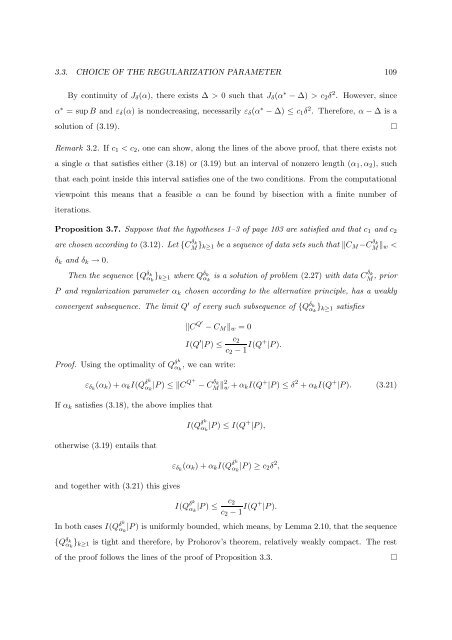Processus de Lévy en Finance - Laboratoire de Probabilités et ...
Processus de Lévy en Finance - Laboratoire de Probabilités et ...
Processus de Lévy en Finance - Laboratoire de Probabilités et ...
Create successful ePaper yourself
Turn your PDF publications into a flip-book with our unique Google optimized e-Paper software.
3.3. CHOICE OF THE REGULARIZATION PARAMETER 109<br />
By continuity of J δ (α), there exists ∆ > 0 such that J δ (α ∗ − ∆) > c 2 δ 2 . However, since<br />
α ∗ = sup B and ε δ (α) is non<strong>de</strong>creasing, necessarily ε δ (α ∗ − ∆) ≤ c 1 δ 2 . Therefore, α − ∆ is a<br />
solution of (3.19).<br />
Remark 3.2. If c 1 < c 2 , one can show, along the lines of the above proof, that there exists not<br />
a single α that satisfies either (3.18) or (3.19) but an interval of nonzero l<strong>en</strong>gth (α 1 , α 2 ), such<br />
that each point insi<strong>de</strong> this interval satisfies one of the two conditions. From the computational<br />
viewpoint this means that a feasible α can be found by bisection with a finite number of<br />
iterations.<br />
Proposition 3.7. Suppose that the hypotheses 1–3 of page 103 are satisfied and that c 1 and c 2<br />
are chos<strong>en</strong> according to (3.12). L<strong>et</strong> {C δ k<br />
M } k≥1 be a sequ<strong>en</strong>ce of data s<strong>et</strong>s such that ‖C M −C δ k<br />
M ‖ w <<br />
δ k and δ k → 0.<br />
Th<strong>en</strong> the sequ<strong>en</strong>ce {Q δ k<br />
αk<br />
} k≥1 where Q δ k<br />
αk<br />
is a solution of problem (2.27) with data C δ k<br />
M , prior<br />
P and regularization param<strong>et</strong>er α k chos<strong>en</strong> according to the alternative principle, has a weakly<br />
converg<strong>en</strong>t subsequ<strong>en</strong>ce. The limit Q ′ of every such subsequ<strong>en</strong>ce of {Q δ k<br />
αk<br />
} k≥1 satisfies<br />
‖C Q′ − C M ‖ w = 0<br />
I(Q ′ |P ) ≤ c 2<br />
c 2 − 1 I(Q+ |P ).<br />
Proof. Using the optimality of Q δk<br />
α k<br />
, we can write:<br />
ε δk (α k ) + α k I(Q δk<br />
α k<br />
|P ) ≤ ‖C Q+ − C δ k<br />
M ‖2 w + α k I(Q + |P ) ≤ δ 2 + α k I(Q + |P ). (3.21)<br />
If α k satisfies (3.18), the above implies that<br />
otherwise (3.19) <strong>en</strong>tails that<br />
and tog<strong>et</strong>her with (3.21) this gives<br />
I(Q δk<br />
α k<br />
|P ) ≤ I(Q + |P ),<br />
ε δk (α k ) + α k I(Q δk<br />
α k<br />
|P ) ≥ c 2 δ 2 ,<br />
I(Q δk<br />
α k<br />
|P ) ≤ c 2<br />
c 2 − 1 I(Q+ |P ).<br />
In both cases I(Q δk<br />
α k<br />
|P ) is uniformly boun<strong>de</strong>d, which means, by Lemma 2.10, that the sequ<strong>en</strong>ce<br />
{Q δ k<br />
αk<br />
} k≥1 is tight and therefore, by Prohorov’s theorem, relatively weakly compact. The rest<br />
of the proof follows the lines of the proof of Proposition 3.3.
















